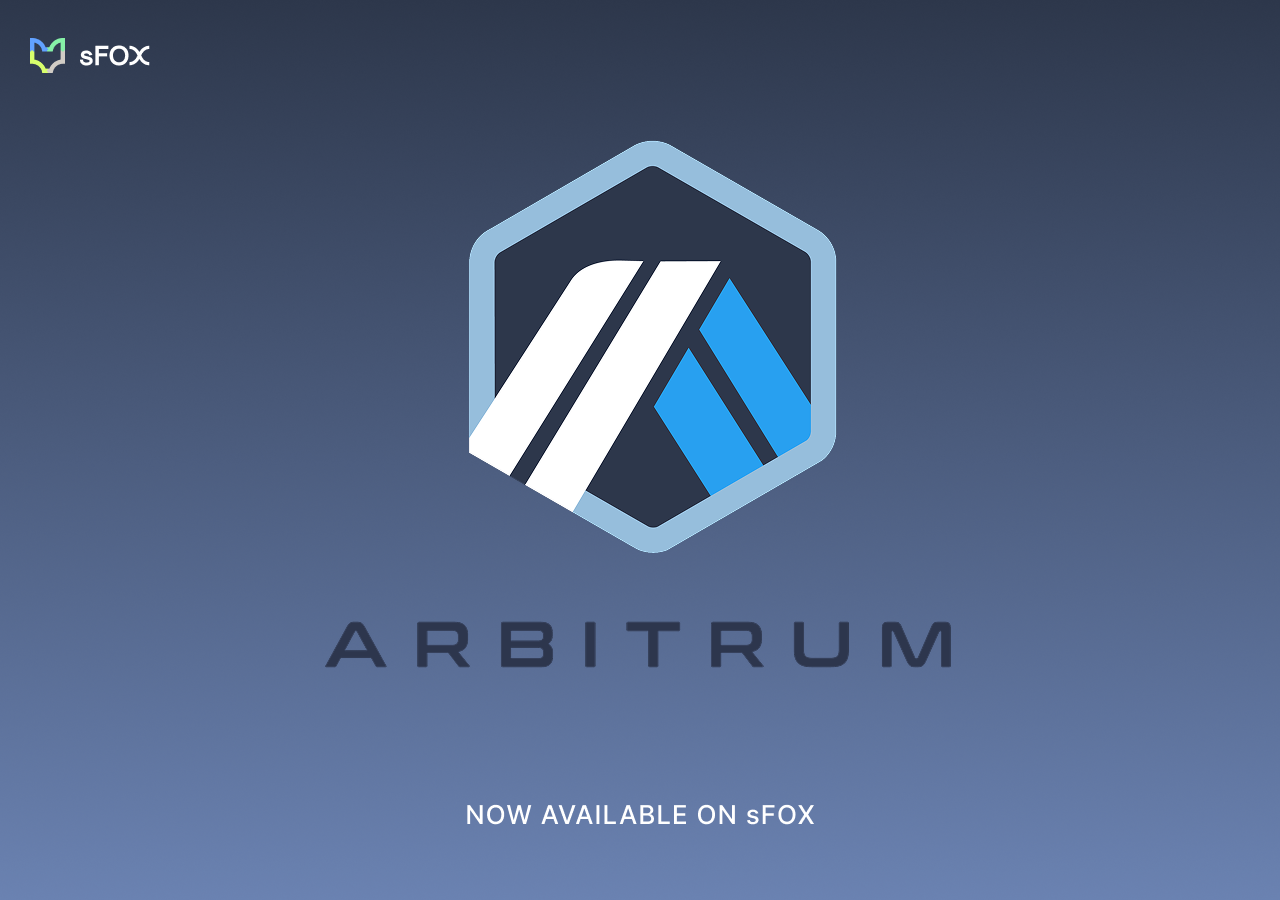Almost three years ago, the first public version of Ethereum was released. The new blockchain was born from a whitepaper by Vitalik Buterin, a young man who cut his teeth in the cryptocurrency space writing for Bitcoin Magazine.
Ethereum distinguished itself from Bitcoin right from the start, in its whitepaper. Whereas Bitcoin was intended to be a digital currency or a store of value, Ethereum was intended to be a kind of decentralized supercomputer: “a blockchain with a built-in fully fledged Turing-complete programming language that can be used to create ‘contracts’ that can be used to encode arbitrary state transition functions.”
These two very different blockchains now have the two largest market caps of any cryptocurrencies, with BTC at $128,469,761,721 USD at time of writing, and ETH at $58,534,876,766 USD. But beyond their mutual success, how have these two cryptocurrencies performed relative to each other over the years?
Here’s how Ethereum stacked up to Bitcoin back then, on August 7, 2015:
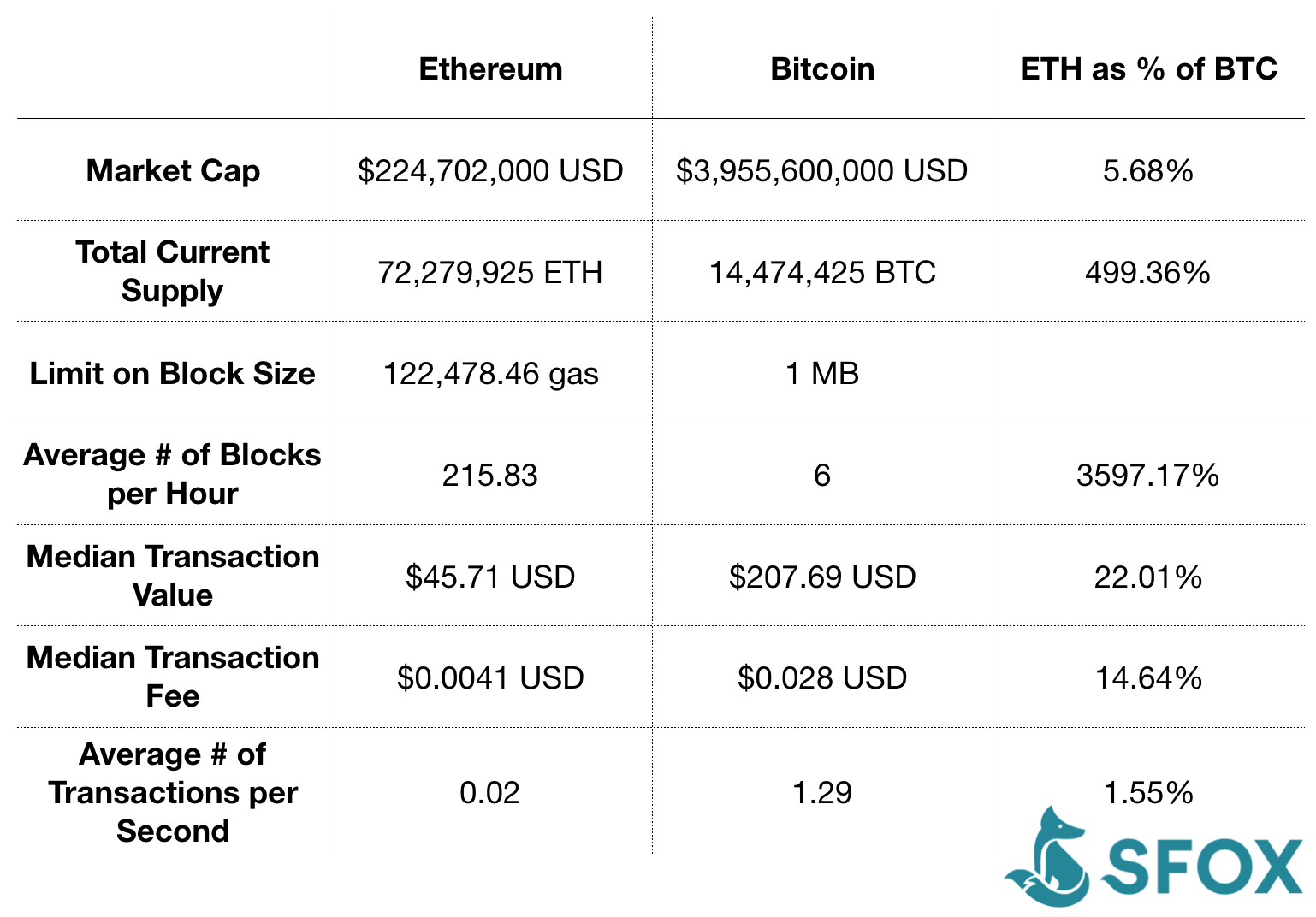
Here’s how that compares to Bitcoin vs Ethereum today (May 24, 2018):
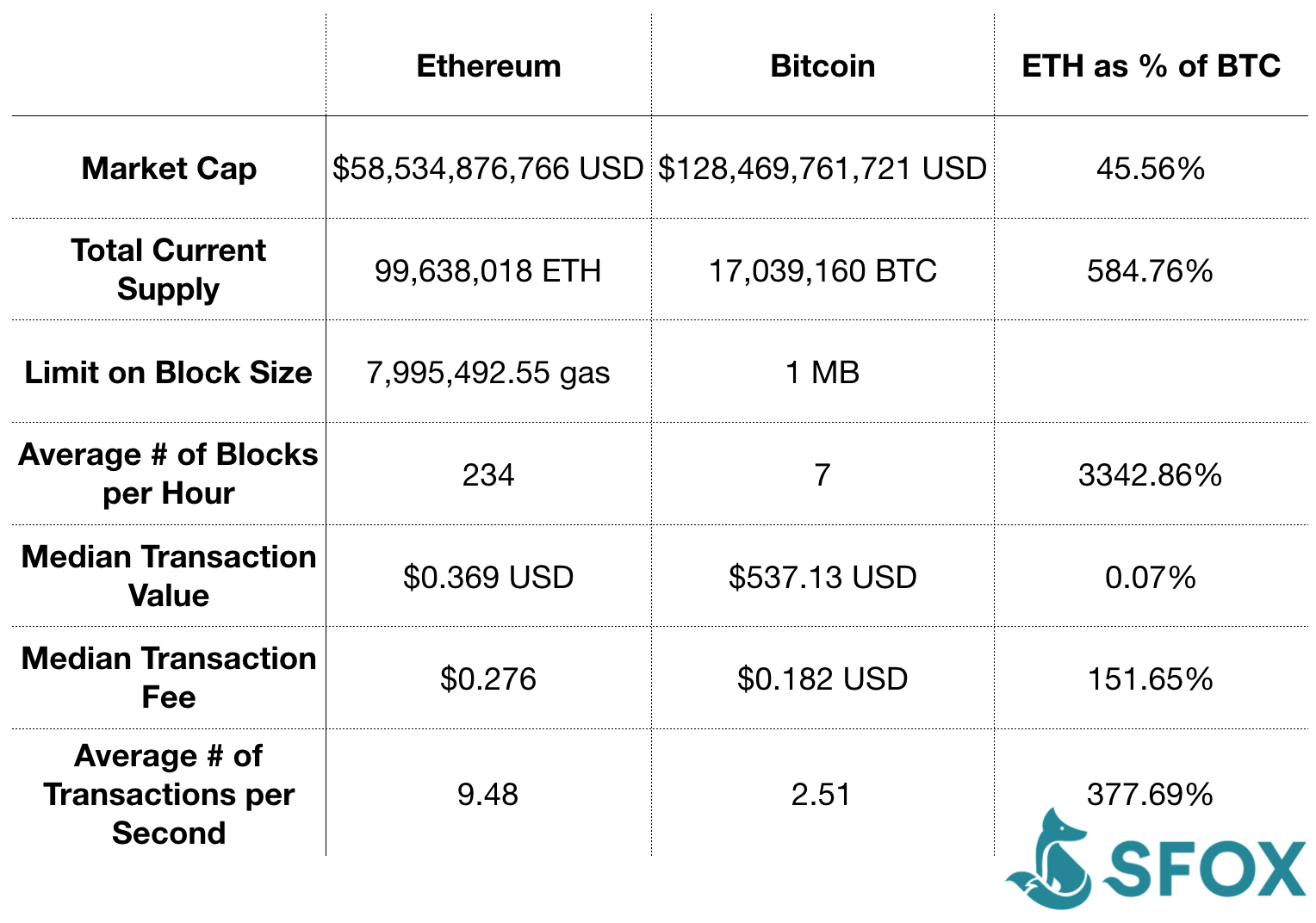
In the last years, Ethereum has grown into the second largest cryptocurrency by market cap, currently valued at almost $60 billion behind Bitcoin’s almost $130 million. But, contrary to what groups such as those advocating “The Flippening” would have you believe, this growth isn’t the story of one cryptocurrency fighting to eclipse another: rather, it’s the story of two very different kinds of projects succeeding, driving the growth of a whole new sector.
Bitcoin and Ethereum have radically different use cases
How would you compare Apple to Amazon? Sure, they’re both publicly traded technology companies, but they’re also businesses with totally different goals, business models, and products.
That’s what it’s like to compare Bitcoin and Ethereum: even though they’re both leading blockchain networks, they have totally different goals, use cases, and design philosophies.
You can see this in the structure of each network. Coding for Bitcoin is like writing assembly code, whereas coding for Ethereum is much more flexible and capacious. This is no accident:
- Bitcoin is intended to be digital money and a store of value, but this makes its programmability limited: you don’t want someone programming and stealing your money at the same time.
- Ethereum is intended as a development platform and therefore is easy to program — but that makes it susceptible to vulnerabilities like the parity bug and the DAO hack.
If Bitcoin and Ethereum were designed for different things, then what exactly are their use cases? Take a look at this table:
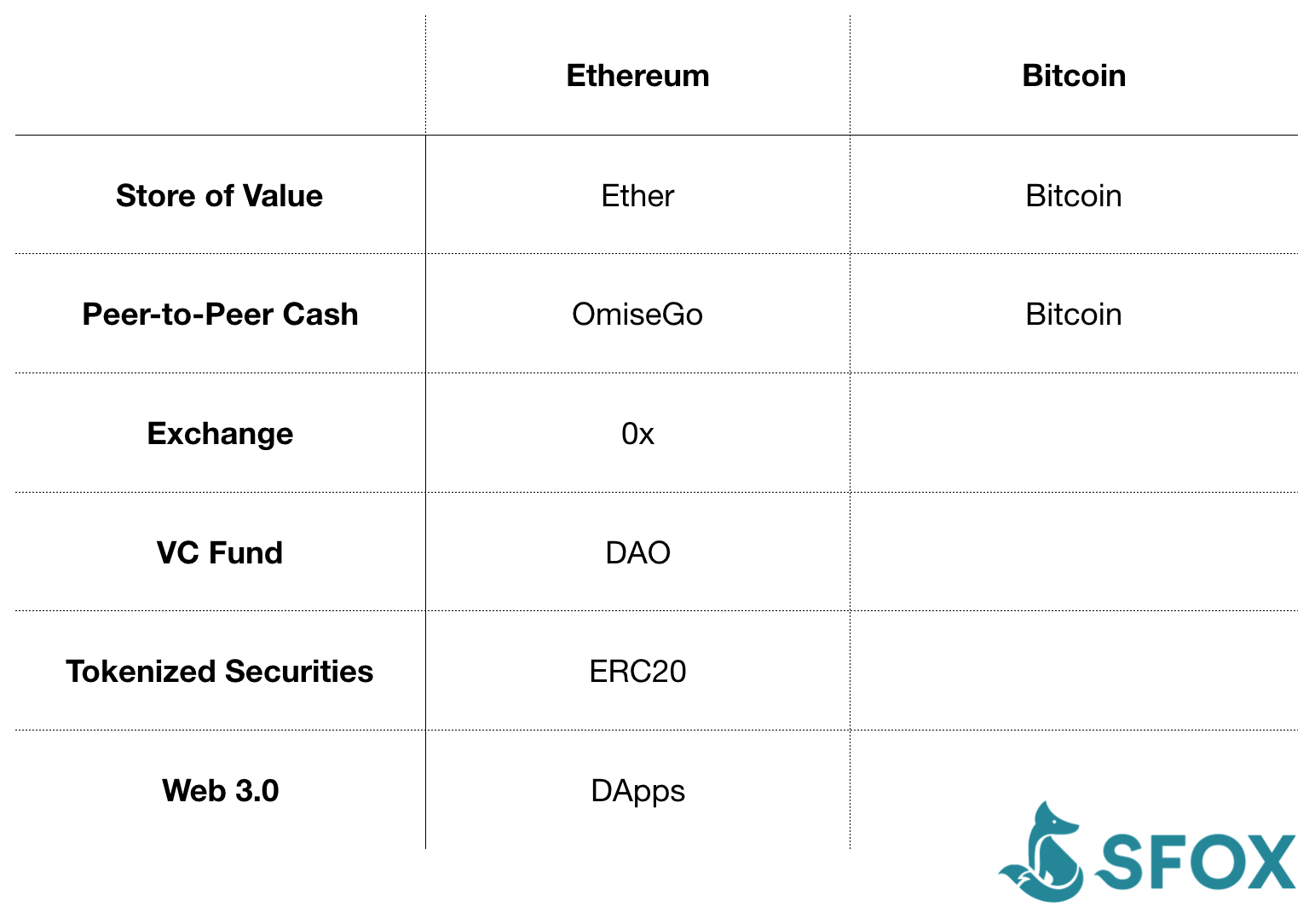
This chart reflects that, fundamentally, Ethereum is a platform, whereas Bitcoin is more of a currency. Therefore, Ethereum isn’t competitive with Bitcoin: unlike Bitcoin Cash, which intends to supplant Bitcoin as a form of digital cash, BTC and ETH can and have grown without cannibalizing each other.
The smart contracts that operate on Ethereum’s virtual machine are empowering developers to build everything from collectible, non-fungible cartoon cats to decentralized securities exchanges. This platform-oriented design has led increasingly more developers to rally around Ethereum, which has been reflected in the growth of the network’s annual developer conference, Devcon: in three years, it’s grown from 50 attendees to over 2,000.

People have recognized the value of Ethereum as a platform, which is most obvious in the amount of money that’s been put into ICOs — ”initial coin offerings” — by startups issuing tokens built on the Ethereum network. In 2017, over $5.6 billion was invested in ICOs; that entire amount was surpassed by the first three months of ICO investment in 2018, which totaled $6.3 billion.
According to CNBC, ICO investments now surpass early-stage VC funding for internet companies. That’s not to say VCs haven’t been paying attention, though — for example, Andreessen Horowitz and Union Square Ventures invested a combined $12M in CryptoKitties.
The heavy focus on ICOs in the press might make you think that all the developers are flocking to Ethereum from Bitcoin, but that’s not the case. In fact, if you take a look at Github, you’ll see that ‘Bitcoin’ is mentioned in almost 60% more repos than ‘Ethereum’ is.

How can we make sense of the discrepancy between the many public development projects on Ethereum and the broader development community behind Bitcoin? This seems to be a case of breadth vs. depth: whereas Ethereum has people working on a huge diversity of projects (ICOs, layer 2 protocols, etc), Bitcoin has many people working on a single thing (Bitcoin). The difference in the cryptocurrencies’ communities, in other words, reflects the difference in their use cases.
Ethereum has grown faster than Bitcoin
A product that invents a new market will have to work hard to get traction. The products that follow it in that market will have a correspondingly easier time getting traction. Only by carving out their own niches will these different products survive in the long run. You can see this all over the place:
- Uber and Lyft
- Netflix and Hulu
- Bitcoin and Ethereum
Bitcoin didn’t surpass a $55 billion market cap until August 8th of last year — over 7 years into its existence. Ethereum crossed that market cap for the first time on December 13th of last year, just about 2-and-a-half years into its existence.

Ethereum also captured a fair amount of overall market dominance from Bitcoin fairly quickly, despite the facts that it was relatively late to the cryptocurrency space and Bitcoin had the advantage of being the very first cryptocurrency.
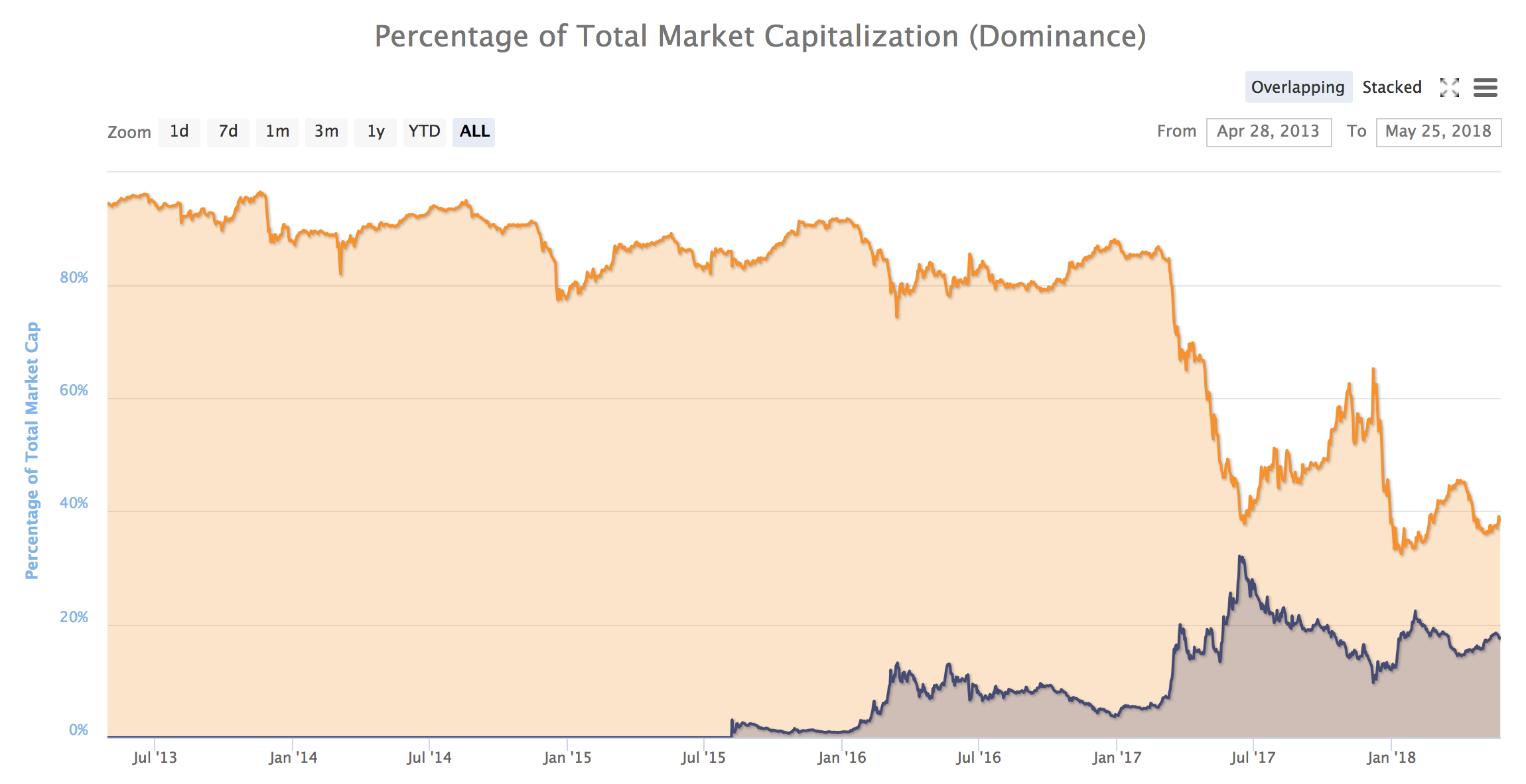
It took Bitcoin until December 9, 2015 — over 5 years — to reach a daily transaction volume of 200,000 transactions, whereas Ethereum reached this benchmark on June 6th of last year — about 2 years into its existence. That was the point at which Ethereum’s daily transaction volume surpassed Bitcoin’s.

As with products in other sectors, the first mover (Bitcoin) and the follow-up (Ethereum) have been able to both survive because they are complementary, rather than competitive. People can and do endorse both Ethereum as a platform and Bitcoin as a store of value.
And, all things considered, it’s probably better that Bitcoin came first: the notion of “digital gold” is easier to grasp than a “decentralized supercomputer,” meaning that BTC probably primed people to understand ETH’s value proposition more readily.
Scaling is a more pressing issue for Ethereum than for Bitcoin
Both Ethereum and Bitcoin need to handle many more transactions than they can at present — but that need is more urgent for one of them than it is for the other.
To get a rough-and-ready handle on orders of magnitude, think about the transaction goals of Bitcoin and Ethereum as similar to those of VISA and Facebook, respectively.
- VISA is capable of handling 24,000 transactions per second.
- Facebook handles roughly 200,000 transactions per second (assuming roughly 1 million users online at any given minute, each taking an action every 5 seconds).
Assuming that Bitcoin wants to have the transactional capacity of VISA and Ethereum wants to be able to support dapps as far-reaching as Facebook, Ethereum has to be able to handle transactions that are an order of magnitude greater than Bitcoin’s.
This is why Ethereum is pursuing a slew of scaling solutions, whereas Bitcoin is only really focused on a single main solution right now.
Here are some of the main strategies Ethereum developers are pursuing right now to help with scaling:

Ethereum developers are well aware of how much they need to scale in order to run dapps with billions of people, which is why so many teams are targeting basically any opportunity, on-chain or off-chain, to increase Ethereum’s transaction capacity.
In contrast, Bitcoin is mainly focused on using Lightning Network to increase its transaction capacity. This is a Layer-2 scaling solution that provides an off-chain payment channel for the network. In that way, it’s similar to Raiden Network — one of the many scaling solutions that Ethereum developers are pursuing.
Over time, it’s virtually inevitable that both Bitcoin and Ethereum will scale tremendously. But right now, it’s more important for a decentralized supercomputer to handle tons of transactions than it is for digital gold or digital cash.
The future of Bitcoin and Ethereum: a complementary ecosystem
The success of Bitcoin is not mutually exclusive from the success of Ethereum. In fact, having robust developer communities behind both cryptocurrencies probably does a lot to improve the chances of crypto succeeding as an entire sector.
Ethereum may be chasing Bitcoin in terms of market cap, but both BTC and ETH are still very much in the early days of growing and maturing. Time will tell what lies ahead for their communities.
The above references an opinion and is for informational purposes only. It is not intended as and does not constitute investment advice, and is not an offer to buy or sell or a solicitation of an offer to buy or sell any cryptocurrency, security, product, service or investment. Seek a duly licensed professional for investment advice. The information provided here or in any communication containing a link to this site is not intended for distribution to, or use by, any person or entity in any jurisdiction or country where such distribution or use would be contrary to law or regulation or which would subject SFOX, Inc. or its affiliates to any registration requirement within such jurisdiction or country. Neither the information, nor any opinion contained in this site constitutes a solicitation or offer by SFOX, Inc. or its affiliates to buy or sell any cryptocurrencies, securities, futures, options or other financial instruments or provide any investment advice or service.



